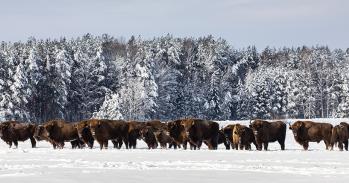
Conservation scientists working in partnership with practitioners and policy makers are building practical tools for real-world conservation.
Conservation scientists working in partnership with practitioners and policy makers are building practical tools for real-world conservation.
Conservation has to be mainstreamed. It can’t be on the margins.
Professor Andrew Balmford
Just under a decade ago, a target was set by the world’s governments: to slow the decline in biodiversity within 10 years. But by 2010 it was clear that global efforts had largely failed. The state of biodiversity had worsened and the ecosystem services that we rely on for food and water, a stable climate, and protection from natural disasters continue to be in jeopardy.
As plans were drawn up for a new strategic plan for the next decade, the Secretary-General of the United Nations stated that conservation efforts are all too often undermined by conflicting policies; yet, “conserving biodiversity,” he said, “cannot be an afterthought once other objectives are addressed.”
It’s a sentiment echoed by Professor Andrew Balmford, who helps lead the University of Cambridge’s Conservation Science Group in the Department of Zoology: “Conservation has to be mainstreamed. It can’t be on the margins. It has to be part of policy and practice across a whole range of sectors if we are to have a chance of counteracting the rapid declines in the extent and condition of natural ecosystems.”
With this in mind, he and Professor Rhys Green, the Royal Society for the Protection of Birds (RSPB)’s Principal Research Biologist and also based in the Department of Zoology, have created a series of highly effective partnerships with conservation practitioners and policy makers. These in turn have developed a suite of tools aimed at helping decision makers make informed judgments.
“Conservation has for too long suffered from key disconnects,” explained Balmford. “One of the main problems is conservation research is often about biology, but the global loss of nature is really about people and what they do. To tackle fundamental questions about this relationship, quantitative research studies need to be linked to policies and practice that are capable of effecting behaviour change.”
“It’s an iterative process,” added Green. “Smart collaborations involve policy makers or conservation practitioners identifying the questions that need tackling and, through a dialogue with scientists, turning these into tractable research questions that researchers can answer in ways that are fit for purpose. It’s conservation in the round.”
Smart collaborations are a key part of the vision of the Cambridge Conservation Initiative (CCI), a pioneering collaboration between the University and eight leading conservation organisations and a conservation network based in the Cambridge area that integrates research, policy, practice and learning. Collaboration and funding through CCI have enabled Balmford and Green to address a series of questions that have important implications for global conservation and environmental management.
How, for instance, can the world respond to the growing demands for increased food production and yet conserve the raw material that biodiversity represents? A project led by Dr Ben Phalan from the Department of Zoology, and funded by the Newton Trust and CCI partners BirdLife International, RSPB and the United Nations Environment Programme World Conservation Monitoring Centre (UNEP-WCMC), is using recently developed global datasets to understand better how conflicts between conservation and farming in the tropics might be resolved.
“The expansion and intensification of agriculture are the greatest source of threat to biological diversity,” explained Phalan, “and yet there is little information about how far priority areas for conservation and food production overlap. To what extent will the expansion of a particular crop threaten wild species? Are there areas where expansion of food production would be less of a problem for biodiversity?”
Following input from policy experts at a workshop held in the project’s early stages to identify focal crops, Phalan has been intersecting detailed maps of bird and crop distributions in the tropics, where agricultural expansion is most likely to affect biodiversity. Once completed later in 2012, the study will help decision makers identify the most damaging crops and the most vulnerable areas, both now and under future scenarios of agricultural change.
Another collaboration deals with the problem of how to assess the full benefits that an area’s biodiversity brings to society – its ‘ecosystem services’. These can include the formation of soils, provision of clean water, production of crops, regulation of climate and opportunities for recreation. Most are hard to measure without expert support. So when faced, for instance, with pressures to cut down a natural forest to increase food production, how can local decision makers accurately value the ecosystem services and weigh up the implications of the proposed change in land use?
An ambitious Ecosystem Services Toolkit to do just this is currently in its testing phase, led by Dr Kelvin Peh from the Department of Zoology with a team from Anglia Ruskin University, BirdLife International, RSPB and UNEP-WCMC. The result is a manual (and eventually an online program) that enables non-experts to make state-of-the-art assessments of ecosystem services in their region, so that they can gauge for themselves how changes in local biodiversity will affect them.
“Linking declining levels of biodiversity with the benefits biodiversity delivers, and the pressures and responses affecting it, is crucial to taking us forward in the ‘post-2010’ global strategic plan for biodiversity,” explained Green. A new approach to understanding this relationship has been the driving force behind yet another project – ‘Linked Indicators’, which, like the Ecosystem Services Toolkit project, was supported by the CCI Collaborative Fund.
The idea behind the project is that indicators of biodiversity levels are easier to understand, communicate and act upon if they are linked together in a set that connects policies to outcomes. Green, one of the leaders of the study, explained: “It’s not enough to be aware of changes to biodiversity levels. It’s a bit like having a depth gauge on the Titanic – why would we want to know how fast things are getting worse unless we have an idea of why, and whether our attempts to do something about it are doing any good?”
The Linked Indicators concept is based on a response–pressure–state– benefit model. It proposes a set of linked indicators for each system of interest. For fisheries, for example, the pressure on marine animals from fishing and ocean temperature is related to the resulting state of marine life, as well as the benefit fishing brings in terms of employment and food, and also the policy response to reduce losses to biodiversity by creating marine protected areas. The links between such indicators represent the best available knowledge of how the ecosystem involved works and the causal relationships between its components.
Where Linked Indicators can help decision makers is to provide them with better tools to assess whether the amount and type of response to biodiversity loss have been implemented on a sufficient scale to arrest or reverse it. The study, which was developed by a team from the Department of Zoology working with BirdLife International, RSPB and UNEP-WCMC, was presented at meetings of the Convention on Biological Diversity (CBD) last year. The ideas it suggests are helping the CBD to improve its ability to track progress towards biodiversity targets post-2010.
“Even in the first few years, all of these projects have demonstrated the value for money that smart collaborations can generate,” added Balmford. “By building accessible tools and strengthening the evidence base for decision makers, we can help them make wise and informed decisions for the future of people and the rest of the planet.”
CCI: collaboration and funding
CCI is a collaboration between the University of Cambridge and nine internationally renowned conservation organisations in the Cambridge area committed to the study and protection of global biodiversity. The founder members of CCI are:
The University of Cambridge: six Departments – Zoology, Geography, Plant Sciences, Land Economy, Judge Business School and the Cambridge Programme for Sustainability Leadership – founded the Cambridge Conservation Initiative along with the partner organisations listed below. Each of these departments has a growing programme of research and teaching in conservation, and work closely together on interdisciplinary programmes as part of CCI.
United Nations Environment Programme World Conservation Monitoring Centre: a branch of the United Nations that undertakes synthesis, analysis and dissemination of global biodiversity knowledge for conventions, countries, organisations and companies.
Fauna and Flora International: acts to conserve threatened species and ecosystems worldwide, delivering global and regional programmes of conservation and community projects.
BirdLife International: is a strategic global partnership of conservation organisations in over 100 countries, working to conserve birds, their habitats and global biodiversity, and to promote sustainability in the use of natural resources.
Traffic International: is a global wildlife trade monitoring network that works to ensure that trade in wild plants and animals is not a threat to the conservation of nature.
International Union for Conservation of Nature: is the world’s largest professional global conservation network, and supports scientific research, manages field projects and unites conservationists to develop and implement policy, laws and best practice.
Tropical Biology Association: is dedicated to building the capacity and expertise of people and institutions to conserve and manage biodiversity in tropical regions.
Royal Society for the Protection of Birds (RSPB): is the largest wildlife conservation organisation in Europe, and works to secure the conservation of biodiversity – especially wild birds and their habitats – through research, education, habitat management and advocacy.
British Trust for Ornithology: is an independent scientific research trust specialising in impartial evidence-based knowledge and advice about populations, movements and ecology of birds and other wildlife.
Cambridge Conservation Forum: is a network that links the diverse Cambridge-based community of conservation practitioners and researchers working at local, national and international levels.
To deliver its ambitious programme CCI works closely with like-minded funding partners. CCI is particularly grateful to Arcadia, who has provided core support for the leadership of CCI and grants for the CCI Collaborative Fund, the Miriam Rothschild Programme for Conservation Leadership, the Miriam Rothschild Travel Bursaries for the Student Conference in Conservation Science and the Miriam Rothschild PhD Studentships. CCI is also deeply grateful to the MAVA Fondation pour la Nature for their support to establishment a unique MPhil in Conservation Leadership.
This work is licensed under a Creative Commons Licence. If you use this content on your site please link back to this page.





